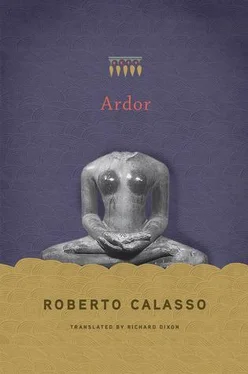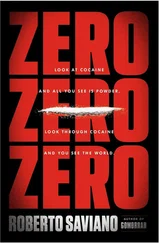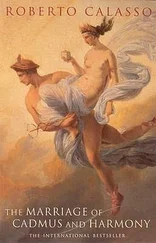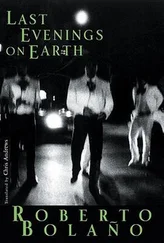With what means did Prajāpati create beings and worlds, in his repeated attempts? With “ardor,” tapas , and with the “vision” of ritual. Connected acts: ardor stirs vision, vision heightens ardor. There is no trace of a will , of a supreme and abstract decision imposed from outside. Or rather: all will is a “desire,” kāma , which is developed in ardor and emerges in vision. No will can be split away from its elaborate physiology.
* * *
Death is not an intrinsic part of divinity, but is an intrinsic part of creation (since successful creation is sexual: in the same way, in the natural world, death will appear together with sexual reproduction). There is no creation without death — and death dwells not only in creatures but also in their Progenitor. So the gods, children of Prajāpati, accused him of creating Death. They were sometimes obsessed by the notion that Prajāpati was himself Death. But, as always with children, they knew little of their father’s past. The fact that he was Year, therefore Time, exposed him to continual disintegration. He could not avoid coexisting with those two inveterate parasites, whom he himself had created but who lurked within him and similarly went to lurk in every other created being.
The connection between evil and Mṛtyu, Death, as well as that between death and desire finally became clear when it was realized that “Death is hunger.” This revelation summed up the bond between desire and evil, through Death. Hunger is a desire, but a desire that involves killing, for it makes something disappear. The inevitability of that Evil which is Death was thus found in the first desire to prolong and perpetuate life, which is hunger.
* * *
Men complained, as the gods had already done, that their father, Prajāpati, had also created Mṛtyu, Death. They always remembered that: “Above creatures, [Prajāpati] created Death as the one who devours them.” But Prajāpati was also the first to feel a terror of Death, which dwelt within him, even though wrapped in something immortal. That part of him feared Death with the same intensity and violence that would later be experienced by humans. The first to escape into hiding — before Agni, Indra, or Śiva — was Prajāpati, who, to escape Death, became water and clay. The earth was first created as a refuge from the fear of Death. And yet Death was benevolent toward Prajāpati. It reassured the gods that it would not hurt him. It knew, in fact, that Prajāpati was protected by the immortal part of him. But Death went further: it invited the gods to seek out their lost father, it invited them to put him back together. The fire altar therefore not only saved Prajāpati from agony, but it put his dismembered body back together at the instigation of Death. An ambiguity that would never be dispelled. After all, Death, of all of his children, had been the first to ask where their father had disappeared. Meanwhile the gods had perhaps already begun to feel the indifference they would later show toward their father. But they set to work and, layer by layer, arranged the bricks of the altar of fire one upon the other.
* * *
It was Prajāpati who defeated Mṛtyu, Death, in an interminable and inconclusive duel (“they continued for many years without succeeding for long in being triumphant”). In the end Death took refuge in the women’s hut. But elsewhere, in other stories (earlier? later? contemporaneous?), Prajāpati is Death. As such, he terrified not just men but also the gods: “The gods were frightened of this Prajāpati, the Year, Death, the Ender, fearing that he, through day and night, might bring an end to their lives.” Various rites were invented to erase — or at least alleviate — the fear: the agnihotra , the New Moon and the Full Moon sacrifice, the animal sacrifice, the soma sacrifice. But they ended in a succession of failures: “In offering these sacrifices they did not attain immortality.”
It was Prajāpati himself who taught the gods and people how to go further. He had seen them busy building a brick altar, but they continually got the size and shape wrong. Like a patient father, Prajāpati told them: “You do not arrange me in all my forms, you make me either too large or not large enough: and so you do not become immortal.” But what should the right form be? That which would succeed in completely filling the cavity of time, by stacking as many bricks as there are hours in the year: 10,800. That was the number of bricks lokampṛṇā , “that fill the space.” And this time the gods succeeded in becoming immortal.
Mṛtyu was worried. He thought that men who imitated the gods would one day have been able to become immortal themselves. So “Death said to the gods: ‘Surely in this way all men will become immortal and what then will be my part?’ They said: ‘From now on no one will be immortal in their body: only when you have taken the body as your part will they who are to become immortal, either through knowledge or through sacred works, become immortal after being separated from their body.’” Even when all the calculations are right, even when the 10,800 + 360 + 36 bricks match Prajāpati’s instructions one by one, the final interlocutor is always Death. He had no intention of relinquishing his part, simply because the gods had become masters in creating forms. If men had now succeeded, through stacking bricks, in becoming immortal, Death would have lost his purpose, like an idle shepherd abandoned by his flock. The gods saw an opportunity here for establishing another obstacle for mankind. They had no intention of watching their own hard-earned privileges being eroded. So a pact was sealed, over the heads of men, between Death and the gods. Yes, men would become immortal, but without their bodies. The mortal remains were surrendered to Death forever. And this is the point that has always made every promise of immortality doubtful. Men in fact preferred their ephemeral bodies to the splendors of the spirit. They distrusted disembodied souls, vaguely tiresome and sinister entities. So the agreement between the gods and Death was seen as a trick.
The celestial immortality granted by the gods to mankind was a reduced immortality. Over the course of time, the celestial body was destined to dwindle and disintegrate. There would be a renewed attraction toward the earth, like a powerful downward suction. Life would begin again in other forms. But death would also be repeated. In this way people ended up seeing their many lives essentially as a sequence of deaths. And they thought that celestial immortality was not enough to escape from repeated death. They had to free themselves from life itself.
Already in the Brāhmaṇas — and not just in the Upaniṣads — the real enemy is not Death, Mṛtyu, but “recurring death,” punarmṛtyu. The obsession with the chain of deaths — and therefore of births — is not Buddhist, but Vedic. The Buddha formulated a radically different way of escaping from the chain. But the doctrine that had prevailed before him was no less bold.
* * *
What happened to Death after the exhausting duel with Prajāpati, after he had taken refuge in the women’s hut? No one ever saw him leave, even to this day. That doesn’t mean that Death disappeared. To see him, all we have to do is look up. The sunlight dazzles us in a diffused glow. But within it we can make out a black circle. It stays, persistently, in the eye. It is a figure, a man in the Sun: that is Death. And it will always be there, for “Death does not die,” protected all around it by the immortal. This is its challenging paradox: the endlessness of the shell also guarantees the endlessness of what it conceals — in this case, Death. When one celebrates the immortal, then at the same time — without knowing it — one celebrates Death, which is “within the immortal.”
Читать дальше












